Long-time hobbyists will recall (with humor, or horror in some cases) the evolution of devices used to create water movement in aquaria. In the mid-1960’s, the use of air pumps coupled with air stones was state of the art. These air stones could be employed in singular fashion, or coupled in air lifts (usually in conjunction with sub-sand or under-gravel filters). In the 1980’s ‘power head’ pumps were introduced. In most cases, these were fan-cooled, alternating current (AC) motors with exposed windings. Those using these early devices will recall salt build-up within the windings of the motors, making for an unpleasant experience when putting your hands in the water (salt water is a wonderful conductor of electricity!). Later, sealed-motor pumps would be imported and made available to North American hobbyists. These devices created discharges with high velocity, but lubrication issues made the drives (motors) unreliable in short order. Bruce Carlson
(then of the Waikiki Aquarium in Honolulu, Oahu, Hawai’i) described a device – the siphon-based Carlson Surge Device – to deliver water movement in high velocity pulses. This remained the epitome of water motion devices for a number of years. Although simple in design and highly reliable, there were drawbacks – these devices introduced a myriad of air bubbles when ‘breaking’ siphon and were noisy, in addition to creating a great deal of salt spray. Improvements in the design of the electric pumps introduced AC power heads with motors encapsulated in epoxy, thus practically eliminating risk of shock/electrocution. A quantum leap was made by Jimmy Chen when he introduced the first ‘propeller pump’ utilizing a small pump modified to drive a small propeller. These propeller pumps have since become the standard for hobbyists wishing to create high amounts of water motion in reef aquaria. For small aquaria, AC propeller (also called ‘prop’) pumps are ideal. The propellers of AC prop pumps
are designed to operate in only one direction, and are engineered to stop the propeller if spinning in the wrong direction. This usually involves some momentary ‘chatter’ when the propeller meets a stop designed into the volute. Effective, but with caveats. For larger aquaria, the state-of-the-art devices are those using direct current (DC) drives. Advantages include a variety of controls and reliability. This leads us to this month’s product review. Previous review of a DC pump Ecotech Marine’s MP-10) can be found here:
http://www.advancedaquarist.com/2009/10/review
This unit has been in service for a year and has proven to be reliable.
This month, we’ll look at the MP40w ES ‘wave maker’ from Ecotech Marine.
For those unfamiliar with the technology associated with the series of vortech pumps, their engineering is simple yet eloquent – a motor on the outside of the aquarium magnetically drives a pump assembly on the inside of the tank. Magnetic-drive pumps have been around for quite some time (ancient hobbyists, such as myself will recall the then revolutionary Dyna-Flo filter introduced by MetaFrame in the late 1960’s) although I never thought these types of pumps would become as powerful as they are today. Through the efforts of the Ecotech Marine engineers, these devices have evolved to become separate magnetically-coupled direct current (DC) motors and propeller pumps (see Figure 1). Controllers, stuffed with micro-electronics, enable the hobbyist to program pump function and speed to an almost infinite number of possibilities. The wireless capability reportedly allows a master controller to operate up to 11 slave pumps.
There are many advantages. The motor is on the outside of the aquarium removing a potential heat source from the water, while improving safety (the motor operates at 24 volts DC).
Ecotech Marine advertises the MP40 to possess the following specifications:
- Flow: 1,000-3,200 gallons per hour (3,785-12,100 liters per hour)
- Power Consumption: 9-28 watts
- Maximum Motor Temperature: 122-140° degrees F (50-60° degrees Celsius)
- Aquarium Wall Thickness: 3/16″ – ¾” (4.76mm – 19mm)
- Appropriate Tank Size Range: 50-500+ gallons (190-1,800+ liters)
- Dimensions:
- Wet Side: 3″ diameter by 2.25″ long (76mm x 57mm)
- Dry Side: 3″ diameter x 2.25″ long (76mm x 57mm)
- Clearance Needed Behind Aquarium: 3′ (76mm)
- Other Dimensions:
- Propeller Diameter: 2-1/8 inches (~54mm)
- Discharge Diameter: 2 ¼” (~mm)
- Cord Length (Controller to Pump): ~8 feet (2.4 meters)
- Cord Length (Electrical Outlet to Transformer): 40 inches (~1 meter)
- Cord Length (Transformer to Controller): 44 inches (1.1 meters)
- Includes: One (1) foam guard and mounting hardware and instruction manual
Operational Modes
The driver is the electronic brain, telling the pump when and how to operate. Speed of the pump as well as operational mode is easily programmed by the user. In addition, the device can operate more than one pump. These slave pumps can be controller wirelessly (see Figure 2).

Figure 2. The electronic brain of the MP40 pump. Various modes of operation allow amazing flexibility.
Constant Speed: This operating option allows the user to adjust pump speed by simply turning a knob. Once the adjustment is made, the setting is saved and the pump runs at a constant speed. This feature allowed me to examine how much water is actually pumped. By recording water velocities at the discharge of the pump and corresponding power consumption (in watts), I was able to determine pump performance. See Figures 3 and 4. This is the first step in evaluating pump performance in other operational modes.

Figure 3. An electronic velocimeter determined water velocities at the discharge of the pump while operating over the range of motor speeds (determined by monitoring motor wattages).
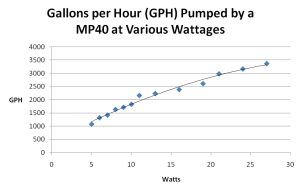
Figure 4. Plugging the discharge velocities shown in Figure 3 into a formula using discharge area, we arrive at gallons pumped.

Figure 5. A ‘power meter’ determined work (as indicated by wattage) performed by the pump over the range of the pump’s power consumption.
Tidal Swell Mode
Although this mode can operate only one pump, Ecotech Marine apparently recommends at least two pumps in order to produce currents originating from either side, and the back of the aquarium.
The pump was allowed to operate in Tidal Swell mode at full speed. After 24 hours, the wattage used was divided by run time. The power used per hour averaged 15 watts. Using the information shown in Figure 4, we determine the average gallons per hour pumped is 2,300 gallons.
Nutrient Transport Mode
As with the Tidal Swell mode, Ecotech recommends at least two pumps should be used to take advantage of flows sufficient to sweep detritus from the aquarium where it can be removed by mechanical filtration or protein skimming.
Random Mode
Random Mode is subdivided into two distinct modes. They are Lagoonal and Reef-Crest. The Lagoonal Mode is advertised to create low energy water motion found in lagoons, while the Reef Crest Mode is said to produce currents such as those found on high-energy reef crests. These are data used to determine performance in the two modes. The pump was set to randomly operate at maximum speed.
- Lagoonal: 16.48 watts (0.39 kilowatts in 23:40 hours)
- Reef-Crest: 12.61 watts (0.31 kilowatts in 24:35 hours)
Short Pulse Mode
As the name implies, this mode allows operation of the pump in on/off cycles ranging in length from 0.3 – 2 seconds, with an almost infinite number of variations in between.
When operating at 2 seconds on/2 seconds off and at maximum speed, the pump pulled an average of 16.77 watts per hour while pumping, on average, 2,500 gallons per hour.
In the test aquarium (a 20-gallon, smaller than recommended by Ecotech Marine), the pump was programmed to produce oscillating wave action and used slightly more power (18.92 watts when in full harmonics, and producing a wave 3″ (~8cm) high.) This equates to ~2,700 gallons per hour. Power pulled ranged from 4 to 30 watts. After 24 hours, the motor temperature reached 110° F (43.3° C). After 28 hours of operation in the short pulse mode the motor temperature has stabilized at 112° F (44.4° C).
The harmonics of the wave action produced deserves further investigation, and more experiments are currently underway.
Long Pulse Mode
As with the Short Pulse Mode, the Long Pulse allows the user to set the pump speed as well as the timing of operation.
The pump operating at 6 seconds on/6 seconds off drew, on average, 14.98 watts (0.37 kW in 24:42 hours) for an estimated flow of about 2,400 gallons per hour. The motor temperature rose to a maximum of 106.7°F (41.5°C) during this time.
Feed Mode
To allow slow-feeding fishes time to eat, the Feed Mode allows the option of manually slowing pump speed for 10 minutes before reverting to the previously programmed mode of operation.
Heat Transfer
Excessive heat is an enemy of the inhabitants of the reef aquarium. While many fishes are often immune to temperature modulations, sessile invertebrates might enjoy a thermally stable environment. Hence, heat transferred to the aquarium by any electrical device in conjunction with infrared energy from a lighting source can potentially cause serious issues.
Although cooling of the tank’s water is possible with some sort of cooling device, it can be an expensive proposition. The best strategy is to avoid any device that transfers undesirable heat to the water.
Ecotech Marine advertises minimal heat transfer even if their direct-current motors operates at relatively high temperature (122°-140°F, or 50 – 60°C).
Heat was monitored with a data logger for 24 hours in various operational modes (see Testing Protocol section below for details). Figure 7 shows the air and water temperature during a 24-hour test when the MP40 was in constant full speed mode.
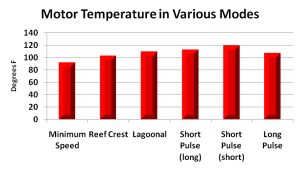
Figure 6. Temperatures were determined with a non-contact infrared thermometer after the motor had been running for ~24 hours. Did motor temperature affect aquarium water temperature? See Figure 7.

Figure 7. Even when the MP40 was operated within an aquarium smaller than recommended, heat generated by the motor did not significantly impact aquarium water temperature.
Noise
Any pump has the potential to create noise. External pumps operating on alternating current (AC) can operate with a mild whining noise especially if fan-cooled. Internal propeller pumps, when operating on direct current (DC), often chatter upon start up. Those least likely to make noise are those AC pumps designed to pump no matter what direction the impeller is spinning, and these are the often the least efficient.
The MP40 is unlike most water-moving devices – it uses a DC motor located outside of the aquarium, with the propeller system located in the aquarium. Since the controller (driver) can be programmed to operate the pump in pulse modes, there is a slight whine as the pump comes to full speed. Subjectively, I did not find this objectionable.
There is a trade-off however. DC motors can run at elevated temperatures. Indeed, Ecotech Marine states the motor can operate at temperatures as high as 140°F, although it is unclear if this is as hot as the motor normally operates, or is the upper thermal limit for proper operation. In any case, we’ll now examine operating temperatures and heat transfer.
Disassembly
As with any pump, the MP40 wet side will have to be periodically disassembled for cleaning. Taking the pump apart and putting it back together is quite easy and requires no tools. A simple twisting action when holding the pump between your hands’ palms is all that is required to open it up. There are no small parts to lose (the propeller assembly uses a nut to attach the prop to a threaded shaft.) Use vinegar to dissolve any calcium compounds. Exercise reasonable care when tooth-brushing the discharge nozzle. The center supports are not especially robust (but much more so than tunze‘s nozzle screen) and might be damaged with over-zealous cleaning.
Options
Battery Backup
In case of a power outage, this battery backup can supply power to the MP40 pump for about 36 hours – more for smaller versions). There have been some issues with previous versions of this backup, but these apparently have been resolved. Transfer to the battery is automatic in case of power loss, and the pump(s) will operate at minimum speed in order to maximize operation time.
Foam Sleeves
These cover the intake of the pump to prevent larger particles from entering. This option is a must if you’re maintaining any fishes that constantly feed (“pickers”) such as any of the long-nose butterfly fishes. One sleeve is included with the MP40.
Price
The price for the MP40w was within a dollar or two when I checked prices at the time of this writing (late October) and was ~$445.00 (plus any applicable tax and shipping charges). Included are the dry/wet side assemblies, controller, electrical cords, one foam sleeve, and owner’s manual.
Although the price might seem high, it is less than most, if not all, comparable pumps (whether made in the US or Europe). The options offer by the controller set this pump a notch above the competition. I highly recommend the MP40.
As a footnote, this product was obtained through normal retail channels.
Wireless Radio Frequency and FCC Compliance
Ecotech Marine’s wireless communication devices comply with FCC regulations.
Error Codes
The control dial will signify via different color patterns many anomalies, including:
- Motor over temperature
- Impeller stalled
- Pump disconnect (requires minimal programming by user)
- Motor Bad
- Unknown pump damage
- Upgrade error(s)
Warranty & Customer Support
One year manufacturer’s warranty on materials and workmanship. Note: The controller is not waterproof and water-related damage is not covered. In addition, the motor is advertised to be ‘fragile’ and, if dropped, could be damaged. This too is not covered.
Contact:
- www.ecotechmarine.com/customer-service/
- [email protected]
- (800) 785-0338
Parts Store
Ecotech maintains a Parts Store on their website. All major parts are available. See: http://ecotechmarine.com/parts-store/
Vendor List
Ecotech does not sell directly to the public (except for the parts mentioned above). Their site lists walk-in and on-line vendors.
Conclusions
Ecotech Marine under-rates the performance of the MP40 pump and flow rates of up to 3,582 gallons per hour have been noted. Historically (based on my experiences with this pump and its smaller brother – the MP10), Ecotech Marine promises less but delivers more. See Figure 8.
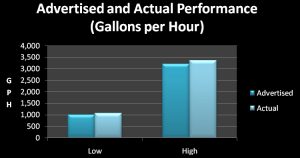
Figure 8. Advertised and actual performance (water pumped) of the MP40 at ‘low’ and ‘high’ speeds. Actual performance exceeds that advertised.
The magnetic drive is a real plus, since it allows a much smaller pump footprint within the aquarium. In addition, there is practically no chance of heat transfer from the motor to the aquarium.
The pump master/slave option is a wireless convenience, adding to an already impressive resume of options.
To my knowledge, the controller offers more operational modes and more versatility than any other pump/controller on the market. These abilities, combined with pump performance, make the MP40 an unparalleled combination for medium sized aquaria. See Figure 9 for further information.
The controller is a small, self-contained light show. When I first plugged it in, and the pump was running in the aquarium, I actually watched the controller’s blinking LEDs (subjectively beautiful) for perhaps 30 seconds or so (when I should have been watching the aquarium). This might be a distraction to some, so Ecotech Marine has made the LED readout dimmable.
Dislikes: The Direction Book uses a very small font and, for me at least, is hard to read. In addition, operational modes are identified by an individual color, and these too are difficult to interpret. If you’re having problems reading the manual, I recommend downloading it from Ecotech Marine’s website. This manual is much easier to read. Be advised it is an 8 Meg file.
Another comment: The MP40 comes with mounting hardware consisting of devices to prevent the motor from dropping to the ground should the magnetic coupling become lost. These devices – cord holders with adhesive backs and small cable ties – are pretty much permanent once mounted. I would much prefer to see a shock-resistant motor, or at the very least, Ecotech Marine offering additional mounting devices on their Parts Store (see below) should I decide to move the pump to another spot or another aquarium.
Price, to some, will be a drawback. However, the MP-10 I have has been in service for well over a year and has performed flawlessly. I have every reason to expect the same from the MP40. The old adage holds true in this case: You’ll remember quality after you’ve forgotten the price.
Testing Protocol
Water velocities were determined using a FloMate 2000 water velocimeter. This device operates on the Faraday principle, where water motion creates measurable distortion in a magnetic field.
Temperatures were gathered with a WatchDog 400 series data logger equipped with an internal sensor that measures air temperature, and a remote micro-sensor to monitor water temperature. Motor temperatures were gathered using a non-contact infrared thermometer.
Power consumption was recorded by a Kill-A-Watt meter marketed by P3 International.
Amounts of water pumped were estimated using the following formula:
Q = V * A
Where:
- Q = Flow (in gallons per hour)
- V = Velocity (in inches per hour)
- A = Area (of the discharge, in square inches)
Comments? Questions? Please leave them in the Comments section below.



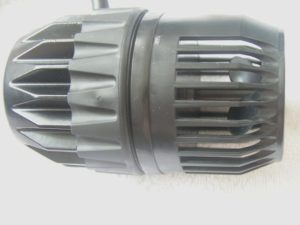
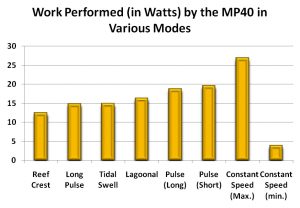

0 Comments